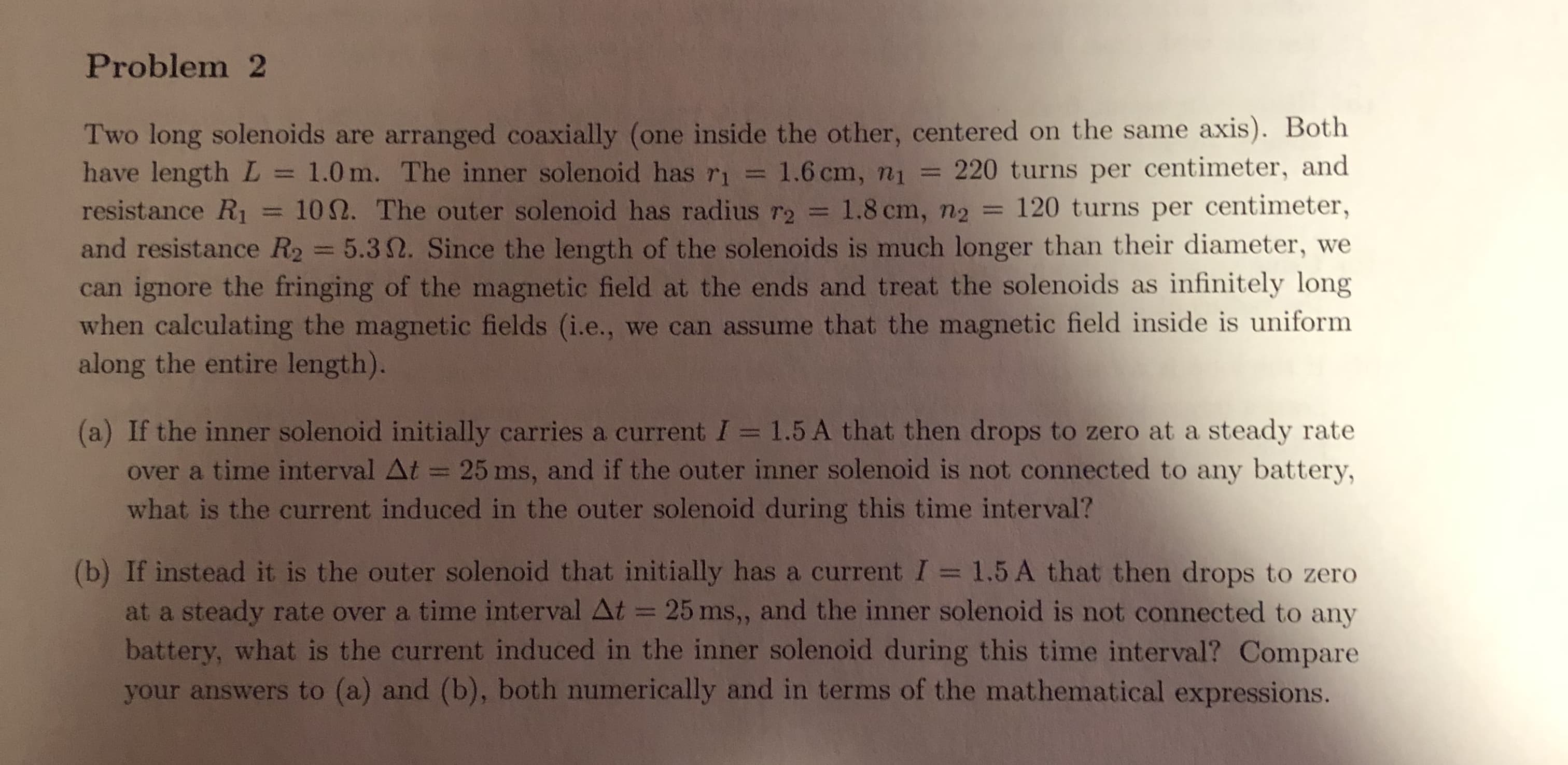Problem2 Two long solenoids are arranged coaxially (one inside the other, centered on the same axis). Both have length L 1.0m. The inner solenoid has r1 1.6 cm, n1 220 turns per centimeter, and resistance Ri = 10Ω. The outer solenoid has radius r2 = 1.8 cm, n2 = 120 turns per centimeter, and resistance R2 5.3 Ω. Since the length of the solenoids is much longer than their diameter, we can ignore the fringing of the magnetic field at the ends and treat the solenoids as infinitely long when calculating the magnetic fields (i.e., we can assume that the magnetic field inside is uniform along the entire length). (a) If the inner solenoid initially carries a current I 1.5 A that then drops to zero at a steady rate over a time interval Δt-: 25 ms, and if the outer inner solenoid is not connected to any battery, what is the current induced in the outer solenoid during this time interval? (b) If instead it is the outer solenoid that initially has a current I 1.5A that then drops to zero at a steady rate over a time interval Δt =-25 ms" and the inner solenoid is not connected to any battery, what is the current induced in the inner solenoid during this time interval? Compare your answers to (a) and (b), both numerically and in terms of the mathematical expressions.
Problem2 Two long solenoids are arranged coaxially (one inside the other, centered on the same axis). Both have length L 1.0m. The inner solenoid has r1 1.6 cm, n1 220 turns per centimeter, and resistance Ri = 10Ω. The outer solenoid has radius r2 = 1.8 cm, n2 = 120 turns per centimeter, and resistance R2 5.3 Ω. Since the length of the solenoids is much longer than their diameter, we can ignore the fringing of the magnetic field at the ends and treat the solenoids as infinitely long when calculating the magnetic fields (i.e., we can assume that the magnetic field inside is uniform along the entire length). (a) If the inner solenoid initially carries a current I 1.5 A that then drops to zero at a steady rate over a time interval Δt-: 25 ms, and if the outer inner solenoid is not connected to any battery, what is the current induced in the outer solenoid during this time interval? (b) If instead it is the outer solenoid that initially has a current I 1.5A that then drops to zero at a steady rate over a time interval Δt =-25 ms" and the inner solenoid is not connected to any battery, what is the current induced in the inner solenoid during this time interval? Compare your answers to (a) and (b), both numerically and in terms of the mathematical expressions.
Principles of Physics: A Calculus-Based Text
5th Edition
ISBN:9781133104261
Author:Raymond A. Serway, John W. Jewett
Publisher:Raymond A. Serway, John W. Jewett
Chapter23: Faraday’s Law And Inductance
Section: Chapter Questions
Problem 6P
Related questions
Question

Transcribed Image Text:Problem2
Two long solenoids are arranged coaxially (one inside the other, centered on the same axis). Both
have length L 1.0m. The inner solenoid has r1 1.6 cm, n1 220 turns per centimeter, and
resistance Ri = 10Ω. The outer solenoid has radius r2 = 1.8 cm, n2 = 120 turns per centimeter,
and resistance R2 5.3 Ω. Since the length of the solenoids is much longer than their diameter, we
can ignore the fringing of the magnetic field at the ends and treat the solenoids as infinitely long
when calculating the magnetic fields (i.e., we can assume that the magnetic field inside is uniform
along the entire length).
(a) If the inner solenoid initially carries a current I 1.5 A that then drops to zero at a steady rate
over a time interval Δt-: 25 ms, and if the outer inner solenoid is not connected to any battery,
what is the current induced in the outer solenoid during this time interval?
(b) If instead it is the outer solenoid that initially has a current I 1.5A that then drops to zero
at a steady rate over a time interval Δt =-25 ms" and the inner solenoid is not connected to any
battery, what is the current induced in the inner solenoid during this time interval? Compare
your answers to (a) and (b), both numerically and in terms of the mathematical expressions.
Expert Solution
This question has been solved!
Explore an expertly crafted, step-by-step solution for a thorough understanding of key concepts.
This is a popular solution!
Trending now
This is a popular solution!
Step by step
Solved in 6 steps with 5 images

Recommended textbooks for you

Principles of Physics: A Calculus-Based Text
Physics
ISBN:
9781133104261
Author:
Raymond A. Serway, John W. Jewett
Publisher:
Cengage Learning


Physics for Scientists and Engineers: Foundations…
Physics
ISBN:
9781133939146
Author:
Katz, Debora M.
Publisher:
Cengage Learning

Principles of Physics: A Calculus-Based Text
Physics
ISBN:
9781133104261
Author:
Raymond A. Serway, John W. Jewett
Publisher:
Cengage Learning


Physics for Scientists and Engineers: Foundations…
Physics
ISBN:
9781133939146
Author:
Katz, Debora M.
Publisher:
Cengage Learning